“Compared to the Sampson Flat fire in 2015, which completely ravaged everything at Mount Bera, we are extremely lucky this time, as although about 30ha of our property has been burnt, it is grazing and bushland, which will hopefully recover. All buildings, vineyards and animals remain untouched,” he says.
‘Only time will tell what this vintage will bring’“We had three days of fire attacks from different directions, and it was stopped at the rim around the house vineyard, and in the valley behind the other vineyards. This was followed by a week or so checking spot fires near containment lines. Only time will tell what this vintage will bring, and fingers are crossed that the fruit will not be smoke-tainted, but we are hopeful as the smoke was generally moving away from the vineyards.”
Things were very different on January 2, 2015, when the Sampson Flat bushfire roared through Mount Bera Vineyards’ 75ha, burning all the vines to varying degrees, as well as every fence at the estate. “The only things not touched were the sheds and house which were well insured. Everything uninsured went up in smoke,” Greg recalls.
The main recovery advice he received at the time was to completely remove the vines and start again. Greg, who makes his own wine and supplies grapes to Penfolds, chose a different path, one that not only saw him harvesting in the first year after the fire, but also resulted in a complete recovery much faster and more cheaply than if he had started from scratch. Here are the key lessons he learned…
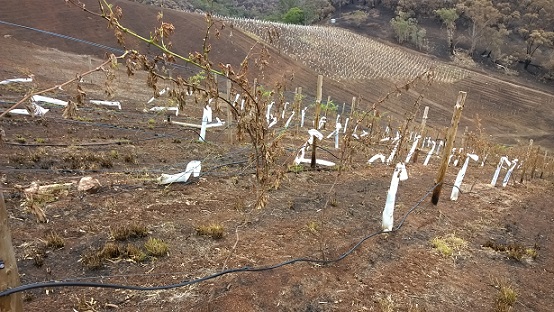
A Shiraz block planted in October 2013. The Pinot Noir in the background was planted in October 2014 – only a couple of months before the Sampson Flat bushfire.
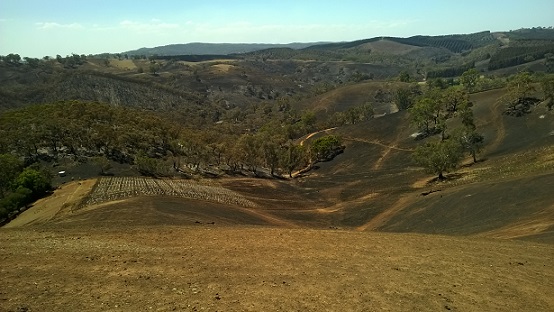
Two days after the fire. The vines directly in view were planted two months earlier. The vineyard on the northwest face to the right was planted the previous season. These two vineyards were the team’s initial focus as the vines were young and needed water.
From the ashes…
First response
Don’t panic and don’t rush to make decisions. Greg realised the vines looked worse than they were. Within four weeks, he started to see reshooting from the ground from vines that had only been planted two months prior, all the way through to 20-year-old vines. Greg observes: “If they are shooting from the ground the vine is telling you the old top has had it. If they are shooting from the trunk then it has a partially burnt trunk but, if possible, wait to get a shoot from the ground. If it is shooting from the cordon there is at least enough trunk function to do something. It may not be able to support a full crop but perhaps some crop is better than nothing whilst you retrain new shoots from the ground for following seasons – in a similar way to Eutypa treatment.”Focus on small wins “to stay positive,” Greg says. “Every shoot of green in the vines or the paddocks lifts your spirits and hope.”
To help prioritise his workload, Greg categorised his three separate vineyards, which grow a wide range of grapes, into the following headings and responses.
Nuked
In these areas, the fire was so intense that timber trellis posts burnt through and plastic vine guards were vaporised. The soil showed evidence of substantial heating 30cm below the surface. Many of these vines (which were planted on their own roots) still reshot and those with dead trunks were later cut off at the base. With hindsight, Greg now thinks an alternative option would be to cut these vines off at ground level immediately, assuming you have the time to do so.Greg comments: “Every single vine reshot – no matter how badly nuked they had been – apart from one vineyard where Eutypa Lata was a problem.”
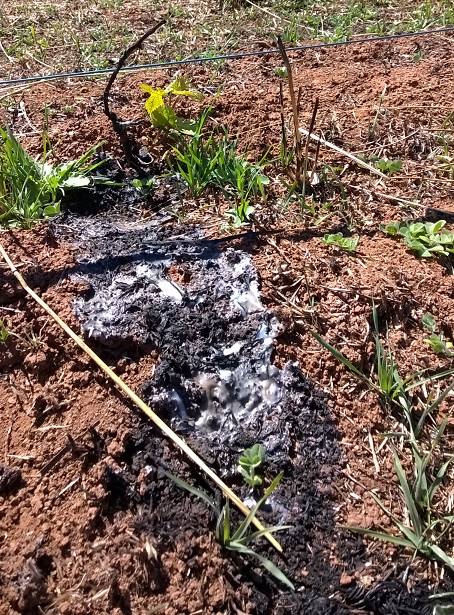
27 days after the fire, a new shoot comes through the charred remains of the young vine and plastic guard.
Partially burnt
Greg developed the following rule of thumb for partially burnt vines:• 50% burnt around the circumference of trunk. These vines usually produced a full crop the following year. This depended how far up the trunk had been burnt.
• 50-75% burnt around the circumference of trunk. When the spurs and the cordon were no longer viable, Greg waited for a water shoot to appear at ground level. “Reshooting from the ground is preferable to anywhere else as the pipeline is clean and will have no restrictions,” Greg says.
“Our preference in all situations was to eventually get to have a new shoot from the ground rather than use a shoot with potentially degraded flow capacity,” Greg says.
Two shoots were selected to replace the damaged trunks and these were simply trained over the existing damaged cordon for the next couple of years to reduce costs. The damaged cordon and trunk were then cut out as time and budget allowed. During that time, Greg still managed to harvest a crop each season.
Grafted vines
While most of the vines at Mount Bera Vineyards are on their own roots, some Merlot rootstock had been grafted to Tempranillo and Shiraz. These were spur-pruned and the above rules were applied when reviewing how much of the cordon and trunk had been burnt. However, they were all left till the following year for the vine to show if the trunk was functioning by looking at the shoot length. Burnt cordons were cut back close to the graft so that a couple of buds were left to shoot and rewrap down. The vines that shot from the ground indicated that the trunk was not functioning and they were regrafted the following year.Pruning
“We left two trunks on the totally beheaded vines to give a larger pipe for the crop in the second year after the fire," Greg explains. "No crop for those ones in the first year after the fire. Back to one trunk in the third year after the fire."For the non-beheaded, partially damaged vines, we trained one shoot up to become the new trunk. If there was no growth upstairs from the old cordon we wrapped the new shoot down. Most of them functioned at least partially. We took out all the old material in the third year so we had a decent crop each year.”
Irrigation
Aside from a newly planted section of vines, irrigation could not be restored to the vineyard until the following season. Greg says his site helped in this regard, as the rich red clay/loam holds a lot of water deep down. Greg believes he would have needed to water earlier if the soil was light and sandy.Equipment
The cost to hire contract labour to do the recovery work was “ridiculous”, so much of the work was done by Greg’s family (Katrina, Kali, Lily, Luka and Maya) and the full-time property hand (Richard). Greg hurt his back using a chainsaw to cut vines off at the base, so he sought a lighter, safer and better alternative – a Black & Decker Alligator battery-powered lopper. This made a major difference during the clean-up. “I cut off more than 15,000 vines without even sharpening it,” Greg states.Cost
Greg says: “For us, the impact was enormous for a couple of years with no income, and then decreased income and lots of rebuilding expenses – so the debt mounts and is still there long after the fire is all but forgotten.”One positive
After the fire, Mount Bera Vineyards planted a couple of new varieties – Blaufrankisch and Zweigelt.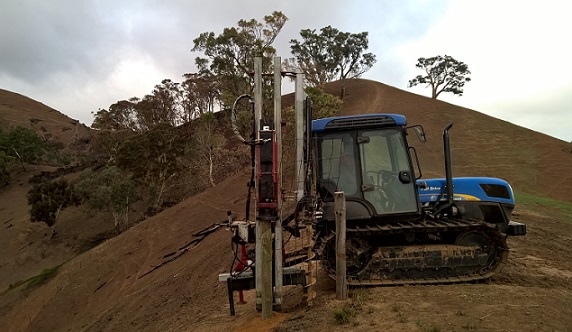
This photo shows the difficult terrain.
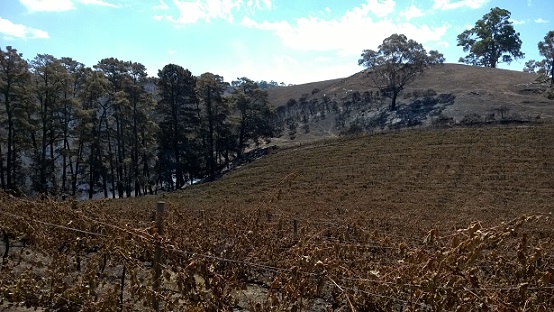
The Saddle Block of 20-year-old Pinot Noir vines, planted on their own roots. The key thing to note here is the row of about 80 pines running along the end of the rows. Planted in the early 1950s, during the fire they became a source of scorching radiant heat! “Everything within visible sight of them was completely nuked,” Greg warns. “There were no strainer posts left and nearly every post in sight was also gone. If you have them near your vineyard, I would recommend getting rid of them as soon as possible.”
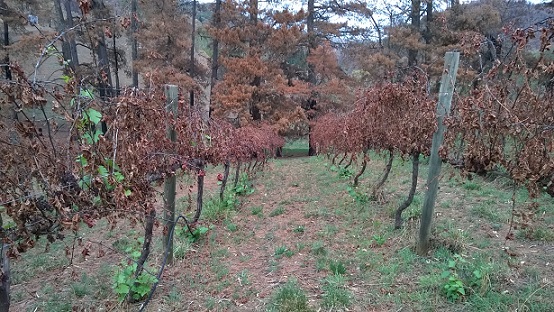
Six weeks after the fire. Despite the extraordinary heat that these 20-year-old Pinot Noir vines, and the soil, were exposed to from the burning pine trees, the root system appears to be alive and pushing out new shoots. Some came later than others, but this was due to the depth from where the new shoot came. “We ended up with about 80% of a desired crop level in 2017,” Greg points out.
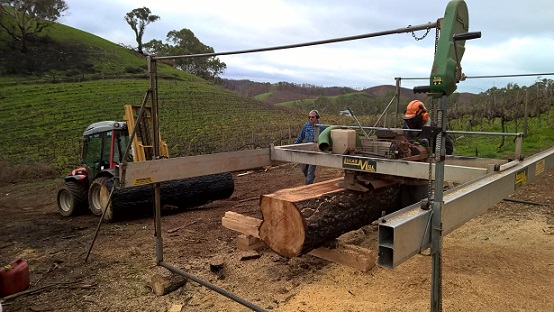
Mount Bera received “ridiculous quotes” to cut down the trees but found someone who cut them down for sleepers on condition that the vineyard team would use their tractor to load up a mobile sawmill. Mount Bera’s new cellar door toilets use some of the redgum slabs to prop up its washbasins.
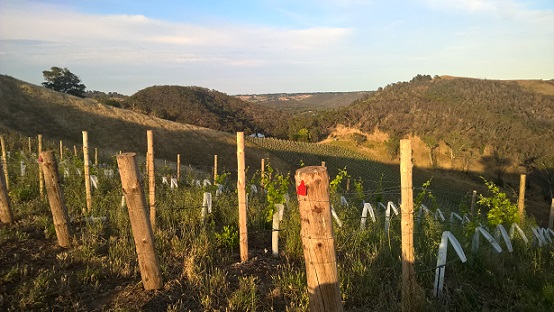
11 months after the fire. The regrowth of the Pinot Noir. Most of the vines were trimmed to two canes to allow enough pipe for the vine to produce a decent crop. “Every single vine reshot – no matter how badly nuked they had been,” Greg says.
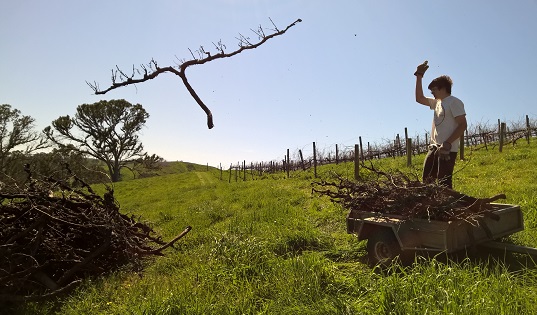
Luka with another old vine on its way to the bonfire pile.
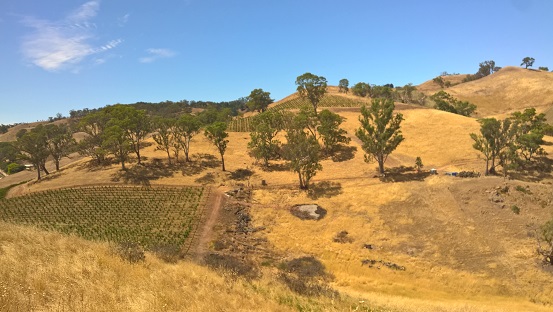
Almost a year after the fire. What fire?
For further information, click here
Related article
Australian bushfires: One winemaker’s storyAfter 21 years of building up the family estate, James Tilbrook has pretty much lost it all…


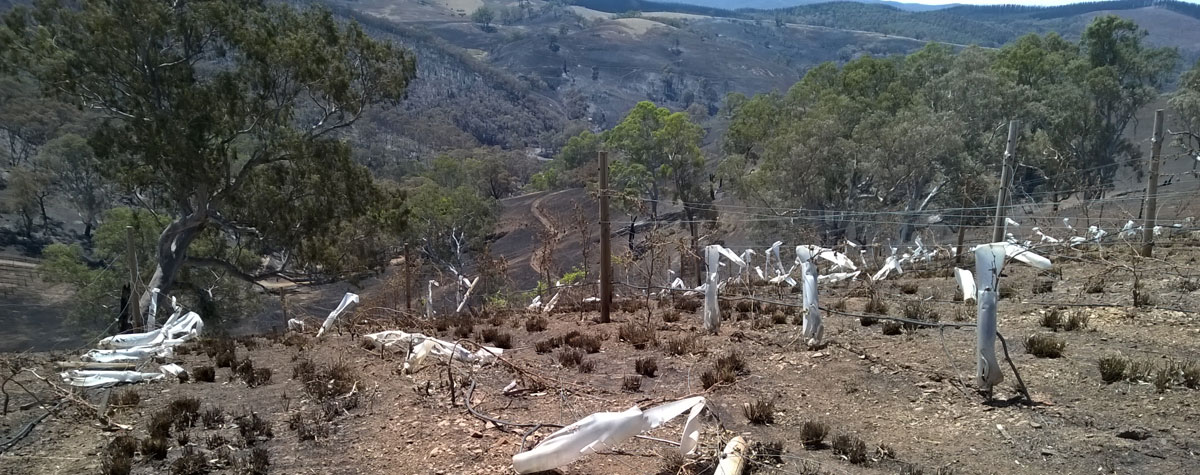










.png)






